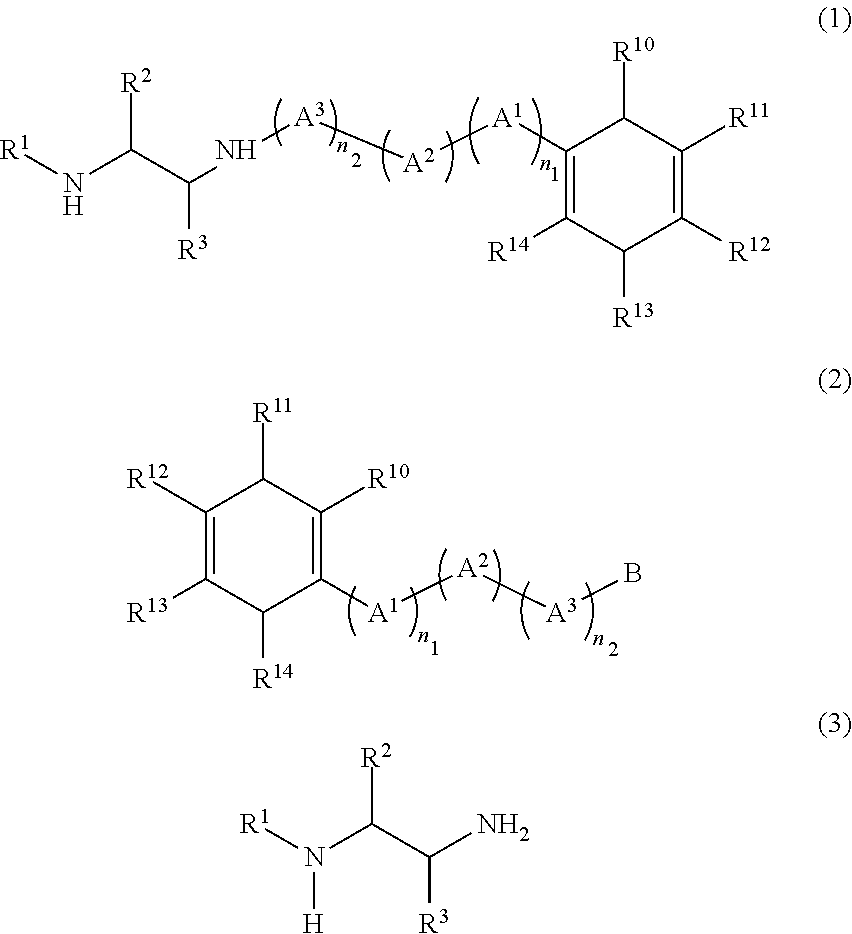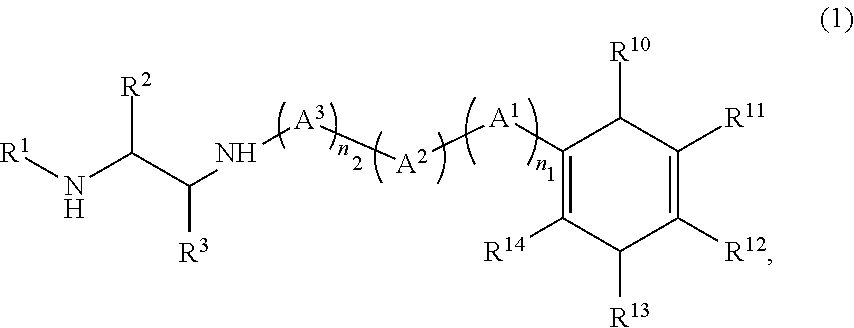Method for producing diamine compound
a technology of diamine compound and diamine, which is applied in the direction of organic compound/hydride/coordination complex catalyst, organic chemistry, physical/chemical process catalyst, etc., can solve the problem of low yield of these complexes, and achieve the effect of simple and efficient production of highly active ruthenium-diamin
- Summary
- Abstract
- Description
- Claims
- Application Information
AI Technical Summary
Benefits of technology
Problems solved by technology
Method used
Image
Examples
example 1
[0073]Production of 4-(4-methylcyclohexa-1,4-dienyl)butan-1-ol and 4-(5-methylcyclohexa-1,4-dienyl)butan-1-ol
[0074]
[0075]In 45 mL of THF, 1,2-bis(diphenylphosphino)ethane (0.77 g, 1.93 mmol), cobalt bromide (0.41 g, 1.87 mmol), zinc iodide (1.19 g, 3.73 mmol), and zinc (0.24 g, 3.67 mmol) were dissolved, followed by stirring at 70° C. for 15 minutes. After cooling to room temperature, isoprene (7.55 g, 110.83 mmol) was added. Then, 5-hexyn-1-ol (8.94 g, 91.09 mmol) was slowly added dropwise with cooling in a water bath. After stirring at 35° C. for 1 hour, the solvent was evaporated under reduced pressure, and the obtained residue was purified by silica gel column chromatography (hexane / ethyl acetate=3 / 1). Thus, 13.34 g of the title compounds, alcohols, were obtained as a colorless oily substance. Yield: 88.1% (isomer ratio: 1,4 type / 1,5 type=77 / 23). Note that the following NMR spectrum data are those of the mixture of the two isomers.
[0076]1H-NMR (CDCl3, 300 MHz): δ 5.61-5.57 (m, 2...
example 2
[0078]Production of 4-(4-methylcyclohexa-1,4-dienyl)butyl 4-methylbenzenesulfonate and 4-(5-methylcyclohexa-1,4-dienyl)butyl 4-methylbenzenesulfonate
[0079]
[0080]The alcohols (12.19 g, 73.32 mmol, isomer ratio: 1,4 type / 1,5 type=77 / 23) obtained in Example 1, triethylamine (8.90 g, 87.98 mmol), and 1-methylimidazole (7.22 g, 87.98 mmol) were dissolved in 10 mL of toluene. With cooling in an ice-bath, a toluene solution (40 ml) of p-toluenesulfonyl chloride (15.94 g, 83.58 mmol) was slowly added dropwise, followed by stirring at room temperature for 1 hour. Water was added thereto, and the resultant layers were separated from each other. The obtained organic layer was washed with 2 M hydrochloric acid and water. The solvent was evaporated under reduced pressure, and the obtained residue was purified by silica gel column chromatography (hexane / ethyl acetate=20 / 1→4 / 1). Thus, 20.25 g of the title compounds, tosylates, were obtained as a colorless oily substance. Yield: 86.2% (isomer ratio...
example 3
[0083]Production of 4-methyl-N-((1S,2S)-2-(4-(4-methylcyclohexa-1,4-dienyl)butylamino)-1,2-diphenylethyl)benzenesulfonamide and 4-methyl-N-((1S,2S)-2-(4-(5-methylcyclohexa-1,4-dienyl)butylamino)-1,2-diphenylethyl)benzenesulfonamide
[0084]
[0085]The tosylates (10.45 g, 32.61 mmol, isomer ratio: 1,4 type / 1,5 type=77 / 23) obtained in Example 2 were dissolved in 40 ml of toluene, and DIPEA (4.79 g, 32.61 mmol) and (S,S)-TsDPEN (11.95 g, 32.61 mmol) were added thereto, followed by stirring at 135° C. for 14 hours. After that, the solvent was evaporated under reduced pressure, and the obtained residue was purified by silica gel column chromatography (hexane / ethyl acetate=2 / 1). Thus, 9.31 g of the title compounds were obtained as a yellow oily substance. Yield: 55.5% (isomer ratio: 1,4 type / 1,5 type=77 / 23). Note that the following NMR spectrum data are those of the mixture of the two isomers.
[0086]1H NMR (CDCl3, 300 MHz): δ 7.38-7.36 (m, 2H+2H′), 7.14-7.12 (m, 3H+3H′), 7.05-7.00 (m, 5H+5H′), ...
PUM
| Property | Measurement | Unit |
|---|---|---|
| temperature | aaaaa | aaaaa |
| temperature | aaaaa | aaaaa |
| temperature | aaaaa | aaaaa |
Abstract
Description
Claims
Application Information
 Login to View More
Login to View More - R&D
- Intellectual Property
- Life Sciences
- Materials
- Tech Scout
- Unparalleled Data Quality
- Higher Quality Content
- 60% Fewer Hallucinations
Browse by: Latest US Patents, China's latest patents, Technical Efficacy Thesaurus, Application Domain, Technology Topic, Popular Technical Reports.
© 2025 PatSnap. All rights reserved.Legal|Privacy policy|Modern Slavery Act Transparency Statement|Sitemap|About US| Contact US: help@patsnap.com



